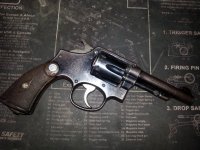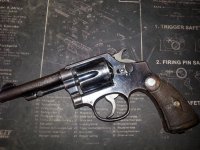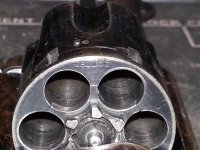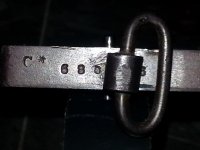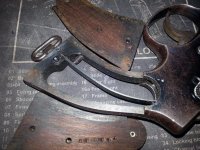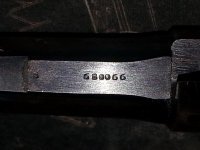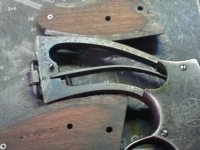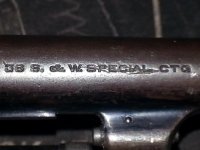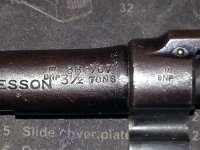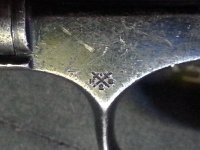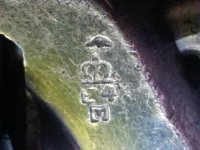I just picked this up yesterday at a local LGS for $125. It is well used with a lot of carry marks and dings. All numbers match on the frame, barrel, cylinder, star and grips. The serial is 680066. It has British proof marks and lanyard ring. It seems odd that it is a "38 S&W Special CTG" marked gun and was sent to the British. It has a C* stamped on the butt and the lanyard hole goes through two serial numbers. There are no US Property marks. Has "Reg US Pat Off" on the back of the hammer. Would like to know more about it, year shipped, pre war, anything helps.
You are using an out of date browser. It may not display this or other websites correctly.
You should upgrade or use an alternative browser.
You should upgrade or use an alternative browser.
British marked 38 S&W Special
- Thread starter Big E3
- Start date
Register to hide this ad
opoefc
US Veteran
Looks like a Model 1905, 4th change, that found it's way to Britain sometime in the past and got itself some British proof stamps and then returned to the US. It may have well been one of the pre-Victory purchases ( not all were 28/200 ) or one of the guns donated to Britain in 1940 by American gun owners. The butt swivel was added by the Brits, I would assume, as S&W would not have drilled through the serial number. Ed.
Thanks, Ed
I have been searching the interwebz and everything I find is about the latter guns shipped in 38 S&W. Most of those were going to South Africa, Australia and Britain. I don't see any other country marks anywhere on this gun. It would make sense that it is a 38 spec if it was a donated gun It seems the cylinder may have been reamed out because 38 Spec ammo is looser than any of my other 38's. The thing that peaked my interest was that the serial number seemed to be very near the start of the contract purchased guns. If it wasn't a 38 spec I would think it could potentially be an early war purchase. Is there any collector interest in the donated early WWII guns or do they need to be contract purchased guns to have interest. Big
I have been searching the interwebz and everything I find is about the latter guns shipped in 38 S&W. Most of those were going to South Africa, Australia and Britain. I don't see any other country marks anywhere on this gun. It would make sense that it is a 38 spec if it was a donated gun It seems the cylinder may have been reamed out because 38 Spec ammo is looser than any of my other 38's. The thing that peaked my interest was that the serial number seemed to be very near the start of the contract purchased guns. If it wasn't a 38 spec I would think it could potentially be an early war purchase. Is there any collector interest in the donated early WWII guns or do they need to be contract purchased guns to have interest. Big
Looks like a Model 1905, 4th change, that found it's way to Britain sometime in the past and got itself some British proof stamps and then returned to the US. It may have well been one of the pre-Victory purchases ( not all were 28/200 ) or one of the guns donated to Britain in 1940 by American gun owners. The butt swivel was added by the Brits, I would assume, as S&W would not have drilled through the serial number. Ed.
Big E3,
Check under the grips to see if the serial number has been stamped on the side of the grip frame. S&W did, on occassion, install an lanyard loop by drilling through the SN, but they would then restamp the number. This was usually done when an order was placed for a revolver with a loop and no unnumbered frame was available.
The serial number should also appear on the rear of the cylinder and under the barrel.
Big E3,
Something is wrong:
C or V PREFIX:
Are you sure the C* that you posted as being on the butt is not meant to be a V; could you have mis-typed the C instead of the V right next to it on the keyboard? A serial # V680066 is much more commensurate with the gun's WW II era features.
STAR:
And if the * is actually a star, that indicates a return to the factory for rework of some kind. Is there a 3 or 4 digit # stamped on the grip frame under the left grip that can be interpreted as a date month and year?
Could we get a photo of the butt stampings?
C PREFIX:
A C prefix to the serial # on the butt would identify it as being a .38 Military & Police produced post war but much later than March 22, 1948. If produced that late, it's much too late to have all the Transitional pre/during the war features such as the stocks, barrel shaped extractor rod knob, cylinder bolt thumb piece style, and the one-line MADE IN USA stamp on the front right side of the frame.
A C prefix gun would have been shipped to the UK, much too late for the war effort.
REAMED CYLINDER:
With matching numbers on all of those parts, the barrel is original to the gun. The cylinder therefore would be originally chambered in 38 S&W Special since its serial # also matches. So I can see no reason to ream out the chambers. And if it was reamed from 38 S&W to 38 Special, it will have two 'shoulders' in each chamber. Does it have 2 shoulders?
BUTT SWIVEL:
As Muley Gil posted above, check the left side of the grip frame for a factory re-stamped serial to verify that it's a factory butt swivel (lanyard ring) installation. Also, if the butt swivel is offset from center 1/10" towards the front, it's a factory installation.
Something is wrong:
C or V PREFIX:
Are you sure the C* that you posted as being on the butt is not meant to be a V; could you have mis-typed the C instead of the V right next to it on the keyboard? A serial # V680066 is much more commensurate with the gun's WW II era features.
STAR:
And if the * is actually a star, that indicates a return to the factory for rework of some kind. Is there a 3 or 4 digit # stamped on the grip frame under the left grip that can be interpreted as a date month and year?
Could we get a photo of the butt stampings?
C PREFIX:
A C prefix to the serial # on the butt would identify it as being a .38 Military & Police produced post war but much later than March 22, 1948. If produced that late, it's much too late to have all the Transitional pre/during the war features such as the stocks, barrel shaped extractor rod knob, cylinder bolt thumb piece style, and the one-line MADE IN USA stamp on the front right side of the frame.
A C prefix gun would have been shipped to the UK, much too late for the war effort.
REAMED CYLINDER:
With matching numbers on all of those parts, the barrel is original to the gun. The cylinder therefore would be originally chambered in 38 S&W Special since its serial # also matches. So I can see no reason to ream out the chambers. And if it was reamed from 38 S&W to 38 Special, it will have two 'shoulders' in each chamber. Does it have 2 shoulders?
BUTT SWIVEL:
As Muley Gil posted above, check the left side of the grip frame for a factory re-stamped serial to verify that it's a factory butt swivel (lanyard ring) installation. Also, if the butt swivel is offset from center 1/10" towards the front, it's a factory installation.
DWalt
Member
With its visible features, the SN cannot have a C-prefix, so your M&P must have either no prefix or a V prefix. If no prefix (which is much more likely), it would likely have been shipped from S&W sometime in 1940, probably early in the year. With a V-prefix (unlikely, as it is blued), 9/44-10/44. Early in the war, the British Purchasing Commission in the U. S. was buying whatever guns they could get wherever they could get them, and also there was a drive to obtain guns from the U. S. via donations from individuals. They didn't much care if the caliber was .38 Special or .38 S&W so long as it would shoot. The prospect of Nazi paratroopers landing in the streets of London was very real at that time. In any event, it's an interesting revolver, and you got it at a very good price. As noted, check to see if all SNs match, especially those on the barrel and the rear face of the cylinder. The grip style is consistent with a ca. 1940 M&P, and the rear of the right grip panel may also have a matching stamped SN.
Regarding the C stamping, does it have a broad arrow inside the C? That would indicate a Canadian gun.
Regarding the C stamping, does it have a broad arrow inside the C? That would indicate a Canadian gun.
Last edited:
Skeetr57
Member
In the members only section of the forum, Ed posted a trivia item based on Carl Helstrom's notes that shows 2150 .38 Spl. blue revolvers shipped to the British in 1941, along with 145 in nickel. That looks like a clean-up shipment of guns in stock, which could account for the added lanyard ring, and the earlier SN.
Ok, I added some requested pictures. I see numbers under the grips on the frame with the "B" on the right side. The back of the right grip panel has the serial number stamped in it. The bottom of the frame with a C* preceding the serial with two numbers covered by the lanyard ring. The bottom of the barrel number is shown with a B to the left. The rear of the cylinder is shown with serial number and as you can see all numbers match. I could not get a picture of the back of the extractor star but the number also matches. The right side of the barrel showing caliber is 38 Special. The left side of the barrel with British proof marks. The grip panel numbers are hard to make out in the picture but do match.
Attachments
Last edited:
DWalt
Member
The .38-767 proofing is interesting. It may indicate that the .38 S&W Special chambers have been re-bored to accept the .38 S&W cartridge (called by the British the ".380 Revolver MkII"). This is because the .38 S&W has a case length of .767", while the .38 Special has a case length of about 1.15". It is logical that this modification would have been made to some .38 Special revolvers in order that they could use the standard British service revolver cartridge, which otherwise could not be chambered. You might see if you can find a .38 S&W cartridge to see if that has been done. I do not know what the C* means - possibly an indication of the rechambering for .38 S&W.
Such proofing was done after the revolvers were declared surplus after WWII, so that they could be sold on the commercial market, as proofing was required for commercial firearms under British law. The BNP means Birmingham Nitro Proof, i.e., proofing was done at the Birmingham Proof House using smokeless powder proof cartridges.
Such proofing was done after the revolvers were declared surplus after WWII, so that they could be sold on the commercial market, as proofing was required for commercial firearms under British law. The BNP means Birmingham Nitro Proof, i.e., proofing was done at the Birmingham Proof House using smokeless powder proof cartridges.
Last edited:
opoefc
US Veteran
I think we can say the C* stamp has no relevance to the gun's S&W ancestry. It could have a connection to this type of conversion of calibers. The 38-767 stamp is seldom seen and I think DWalt has nailed it, in that it is a conversion of the .38 Spl. chambering to accept .38 S&W ( 38/200 ) rounds. All things considered, the evidence still points to the gun being a very early British purchase or a donation under the 'Guns for Britain" program. Ed.
I really appreciate all the input from you guy's I don't have anywhere near the knowledge you all have.
I know S&W did not do shipping in the exact order of serial numbers. However, what I found interesting in the Standard Catalog of S&W was the beginning serial number estimate for shipping war guns to Britain was 680000 and this one is 680066. Could be coincidence but that seems to indicate it would not have been a civilian donation and lends more towards an early 38 special gun that was shipped from S&W stock. I wonder if the Brits were in such a hurry or if S&W did not know at the time the Brits needed a lanyard loop?
I don't have any 38 S&W cartridges to test the cylinder, but it is definitely looser than any other 38 spec. I have. I checked the cylinder dimensions and got .387 at the rear and .356 at the front of the chambers. Do you think I should fire 38 spec from these chambers? Don't feel with chamber issues it would be a great shooter so hopefully it has some collector value. Does anybody want to venture a guess on the value of this gun?
I know S&W did not do shipping in the exact order of serial numbers. However, what I found interesting in the Standard Catalog of S&W was the beginning serial number estimate for shipping war guns to Britain was 680000 and this one is 680066. Could be coincidence but that seems to indicate it would not have been a civilian donation and lends more towards an early 38 special gun that was shipped from S&W stock. I wonder if the Brits were in such a hurry or if S&W did not know at the time the Brits needed a lanyard loop?
I don't have any 38 S&W cartridges to test the cylinder, but it is definitely looser than any other 38 spec. I have. I checked the cylinder dimensions and got .387 at the rear and .356 at the front of the chambers. Do you think I should fire 38 spec from these chambers? Don't feel with chamber issues it would be a great shooter so hopefully it has some collector value. Does anybody want to venture a guess on the value of this gun?
DWalt
Member
With a .387" chamber diameter, the chambers would accept .38 S&W. The .38 Special chamber diameter is closer to .380". You can fire .38 Special cartridges in it. However, you will see bulged fired cases. A great many of the .38/200 Victories imported after WWII had their chambers elongated to accept .38 Special cartridges (sort of the opposite of yours, but with the same result). Not ideal, but not unsafe. If you think it's worth $50 to know, you can order a factory letter to find out where the gun was first shipped by S&W. Its destination may or may not be interesting. I did notice the crude scratching of the barrel caliber marking. Unlike the huge number of converted .38/200 Victories encountered dating from the 1950s and 60s which have no collector value, I believe yours does have some legitimate collector interest, as I would think that these "reverse" conversions probably performed by the British are relatively rare and are in a different category.
Big E3,
Try a 38 S&W round, if it can be chambered, it appears that you're right, it was converted. It will have two shoulders in the chambers. You have a revolver that will shoot both rounds. But the bore is excessively tight for the 38 S&W and may cause leading. It will shoot fine with 38 S&W Special although you will get slightly bulged cases and possibly have to discard a few cases due to cracking.
The butt swivel is not a factory installation and the frame serial # on the butt was not re-stamped on the grip frame. It is currently "defaced" meaning it's an illegal gun. As far as value, no savvy buyer would be interested in buying it.
Try a 38 S&W round, if it can be chambered, it appears that you're right, it was converted. It will have two shoulders in the chambers. You have a revolver that will shoot both rounds. But the bore is excessively tight for the 38 S&W and may cause leading. It will shoot fine with 38 S&W Special although you will get slightly bulged cases and possibly have to discard a few cases due to cracking.
The butt swivel is not a factory installation and the frame serial # on the butt was not re-stamped on the grip frame. It is currently "defaced" meaning it's an illegal gun. As far as value, no savvy buyer would be interested in buying it.
Skeetr57
Member
I have seen some unmolested .38 special cylinders that would accept .38 S&W cartridges, and I have a M1899 S&W that was one of those purchased by the US Navy that has British proof markings that are the same as the gun in question. I have always wondered if it was proofed for the .38 short Colt round, which I believe was a common chambering in England.
I'm surprised that it would be considered "defaced" and illegal since I just bought it last Wednesday from Cabela's. They seemed fine with the serial number being on three other visible places on the gun. I understand that the frame is the legal location for currently manufactured guns. I could just give it to the BATF and let them destroy it, that seems like such a waste if it is an unusual or a rare early transitional British contract gun. I'm reluctant to destroy a piece of history because of a technicality. This issue could explain why nobody has seen very many of these, if every time someone traded one in to a dealer it was sent off to be destroyed.
This gun was made at a time in history that serial numbers were not required. The original serial numbers are still on the gun just not where they would be if it was made after 1968. No one has made an attempt to hide or remove the serial numbers since 1940 when it was new. I have purchased other guns from dealers that were produced before 1968 and never had an issue even without a serial number. In the past I asked local LE about this serial number issue and was told if all the other visible numbers matched they did not have an issue with it.
If it becomes an issue with the BATF, we'll find out in court why Cabela's sold a defaced gun to the unsuspecting public.
Clearly I'm not too savvy because I bought it.
As previously stated I don't have any 38 S&W rounds, If I get brave I'll take it to a gun show and see if someone has one to test the cylinder size.
This gun was made at a time in history that serial numbers were not required. The original serial numbers are still on the gun just not where they would be if it was made after 1968. No one has made an attempt to hide or remove the serial numbers since 1940 when it was new. I have purchased other guns from dealers that were produced before 1968 and never had an issue even without a serial number. In the past I asked local LE about this serial number issue and was told if all the other visible numbers matched they did not have an issue with it.
If it becomes an issue with the BATF, we'll find out in court why Cabela's sold a defaced gun to the unsuspecting public.
Clearly I'm not too savvy because I bought it.
As previously stated I don't have any 38 S&W rounds, If I get brave I'll take it to a gun show and see if someone has one to test the cylinder size.
Last edited:
- Joined
- Jun 28, 2007
- Messages
- 27,660
- Reaction score
- 21,275
Jim is likely correct about the altered serial number on the bottom of the grip frame making the gun illegal, according to the letter of the law. However, if it is in the NICS database with the full six-digit SN (as implied by the complete number being stamped everywhere else) I'm not sure there would be a legal issue. The usual question that arises in this regard is a gun that has had a complete removal of the SN, which is a definite no-no.
My understanding of the SN issue in older guns is they are legal if the gun never had one stamped at the factory, but if it did and is now missing it is illegal. Someone here will correct me if I am wrong.
Two suggestions - bring it back to the store from which you bought it, bring up the issue and let them do the legal legwork. Second, if you keep it, buy the .38 S & W ammo and try to chamber it in the privacy of your own home.
My understanding of the SN issue in older guns is they are legal if the gun never had one stamped at the factory, but if it did and is now missing it is illegal. Someone here will correct me if I am wrong.
Two suggestions - bring it back to the store from which you bought it, bring up the issue and let them do the legal legwork. Second, if you keep it, buy the .38 S & W ammo and try to chamber it in the privacy of your own home.
Absalom
SWCA Member, Absent Comrade
This gun was made at a time in history that serial numbers were not required. The original serial numbers are still on the gun just not where they would be if it was made after 1968. No one has made an attempt to hide or remove the serial numbers since 1940 when it was new. I have purchased other guns from dealers that were produced before 1968 and never had an issue even without a serial number. In the past I asked local LE about this serial number issue and was told if all the other visible numbers matched they did not have an issue with it. .....
I wouldn't get tied in a knot amateur-lawyering any "legal" issue here and creating anxieties. There is no attempt to disguise the serial number, it's obvious, and you can really over-think these things. It has never, to my knowledge, even been conclusively established that partly obscuring a serial number in the process of an alteration, especially by an authorized entity, which would be the presumption here given all the British proof marks, even constitutes "defacing".
Just think of the ten thousands of US Army .38 DA Colts Model 1892, 1894 and 1896, which simply had their serial number (to be found completely only on the butt) ground off, to be lost forever, when they were retrofitted to Model 1901 specs with lanyard swivels in the early 1900s by various arsenals and private companies; they just re-stamped them with the last four digits taken from other parts of the gun. All these in collections today would be contraband instead of being traded all over the country if this were a valid issue.
deadin
US Veteran
Just don't use it in a crime and bring attention to it.....
Similar threads
- Replies
- 17
- Views
- 1K
- Replies
- 9
- Views
- 675
- Replies
- 3
- Views
- 326

